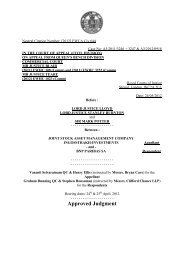Good practice contract management framework - Support
Good practice contract management framework - Support
Good practice contract management framework - Support
You also want an ePaper? Increase the reach of your titles
YUMPU automatically turns print PDFs into web optimized ePapers that Google loves.
20 Section Two <strong>Good</strong> <strong>practice</strong> <strong>contract</strong> <strong>management</strong> <strong>framework</strong><br />
The impact of the risk<br />
2.8 Along with the likelihood of the risk materialising, the overall importance of the risk<br />
is dependent on the impact were the risk to materialise. A risk with a significant potential<br />
impact is clearly more serious and worthy of attention than one that has only a limited<br />
effect. Impact can be considered under the three key risk headings identified above.<br />
<br />
Service failure can generate a wide range of potential impacts. At the extreme, a<br />
service failure by a critical supplier could mean the customer organisation has in<br />
turn to stop providing services. In the public sector, poor supplier performance<br />
could result in the customer not achieving policy objectives or PSA targets, or<br />
in the public who use the service suffering delays and inconvenience. A less<br />
serious service failure (perhaps a service that does not fully meet the standard<br />
or specification required) could generate a more minor loss of efficiency or<br />
effectiveness within the customer organisation.<br />
<br />
Reputational issues can also have an impact on the customer organisation.<br />
While damage may arise from service failure as described above, this is not<br />
necessarily the case. A service <strong>contract</strong> may be delivered to specification but<br />
if, for example, the supplier is found to be using illegal immigrants, there will be<br />
reputational damage and impact for the customer organisation as well as for the<br />
supplier. Quantifying such an impact is, however, often difficult.<br />
<br />
Additional cost is the third key potential impact. The impact of <strong>contract</strong> expenditure<br />
being greater than forecast or budgeted can be considerable, whether it occurs<br />
through poor control, changing requirements, or through unbudgeted but<br />
<strong>contract</strong>ually allowed price increases (for example, where the charges are uprated<br />
for inflation). The internal costs of the customer organisation can also be affected,<br />
whether direct <strong>contract</strong> <strong>management</strong> costs or wider costs driven by <strong>contract</strong><br />
issues. In general terms, the risks associated with a high value <strong>contract</strong> will usually<br />
have greater potential impact, but the specific terms of each <strong>contract</strong> can also<br />
affect the potential costs.<br />
Combining likelihood and impact<br />
2.9 By bringing likelihood and impact together, organisations can assess the<br />
importance of risks, prior to any mitigating actions. Importance can be assessed by<br />
scoring each element and then multiplying the two scores to arrive at a final ‘risk score’.<br />
For instance, likelihood and impact could be rated on a (very simplified) scale such as:<br />
0 Zero likelihood / zero impact<br />
1 Low likelihood / low impact<br />
2 Medium likelihood / medium impact<br />
3 High likelihood / high impact





![[2012] UKUT 399 (TCC)](https://img.yumpu.com/51352289/1/184x260/2012-ukut-399-tcc.jpg?quality=85)





![Neutral Citation Number: [2009] EWHC 3198 (Ch) Case No: CH ...](https://img.yumpu.com/50120201/1/184x260/neutral-citation-number-2009-ewhc-3198-ch-case-no-ch-.jpg?quality=85)





